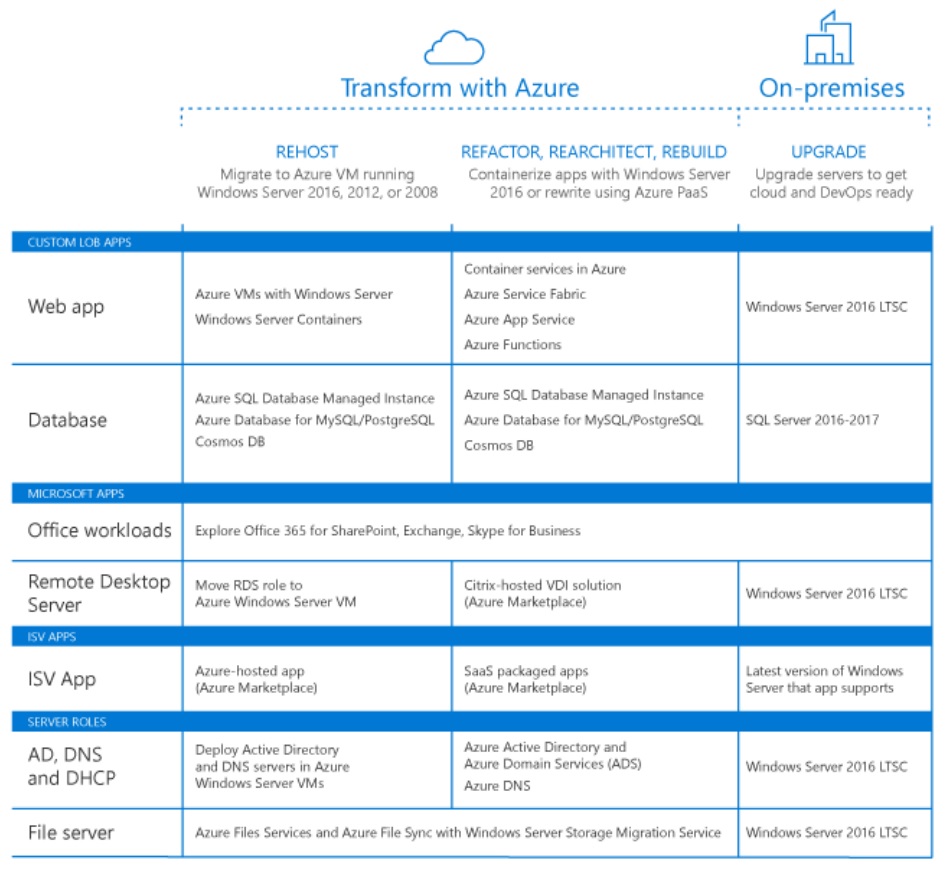One of the key factors driving Azure migration is the need for businesses to improve security and reliability.
Windows Server 2016 offers wide-ranging backwards compatibility combined with full lifecycle support for all Windows Server role workloads in common use.

Active Directory
You can convert existing Windows Server 2008 Active Directory domain controllers to Windows Server 2016 instances running on Azure Virtual Machines, which gives you all the security and reliability improvements in Windows Server 2016 without requiring you to buy or deploy new hardware.
DNS
You can replace your existing on-premises DNS servers with Azure DNS. Modernizing your existing workloads gives you the benefit of all the service and feature improvements of Azure deployments and reduces operating overhead by reducing the number of servers and applications you have to manage.
File and Print Services
Migrate data from file shares to OneDrive for Business, SharePoint Online, or Teams. Windows Server Storage Migration Service helps you migrate servers and their data without reconfiguring applications or users. Because Azure Files securely exposes your file storage areas through the industrystandard SMB protocol, you can use any file copy or migration tool you like to move your content—giving you rich options for moving your data on your own schedule.The Azure Migrate tool can help you identify which specific roles you have in place; using this guide along with its results will help you figure out which server roles should be modernized and which should be moved to the cloud.
For more information, see the Azure Migration Guide for Windows Server.
How can Shoreline Technology Solutions help upgrade my Windows Server 2008?
When it comes to upgrading Windows Server 2008, our techs can help your business assess, migrate, and optimize your upgrade.
- Assess – Identify and inventory your apps and server roles running on Windows Server 2008 and 2008 R2. Analyze each workload to determine the best path—migrate to Azure or upgrade on-premises.
- Migrate – Make the move—migrate your virtual machines to Azure or upgrade to the latest version of Windows Server.
- Optimize – Fine-tune your resources to optimize costs, manage resources, and strengthen security and compliance across hybrid workloads.
Contact us today to learn how our small business server 2008 modernization paths can help protect your business.

President / Network Architect
Mark Kolean always had a fascination with technology from the time he was 3 and his gift of the Atari 2600 to current. In 1990 at the age of 14 Mark got his first job in customer support for a mail order business supporting Tandy TSR-80 computer software shipped on cassette tape. A few years later Mark was building hundreds of 286, 386, and 486 computers for the new emerging DOS & Windows 3.1 computers that had exploded on the market.
After a college career studying business and technology Mark Started Shoreline Computer Systems in 1999 at the height of the dot.com boom with the looming crisis of the year2k bug just around the corner. In the early 2000’s a lot of work was done with early network systems including Lantastic, Novell, and Windows NT Server. Mark became a community contributor to the Small Business Specialist community that revolved around Small Business Server 2000-2011 which focused on single or dual server environments for businesses up to 50 in size. Networks during this time frame mostly had a break fix relationship in which work was billed only when a problem occurred.
In the 2010’s Microsoft released their first cloud based software called Microsoft BPOS which would in later become known as Microsoft Office 365. This introduced a new model in technology with pay as you go subscription services. Starting in 2013 Mark’s team at Shoreline Computer System rebranded as Shoreline Technology Solutions to focus on the transition to become proactive and less reactive to data backup and security needs. Starting in 2018 all customers are required to have a backup management plan in place as a center point with the full understanding that if STS isn’t watching the customer’s data, then no one is.
Now in Mark’s 22 years of business he is building a company emphasis of how to help customers retire servers and build networks completely in the cloud.


Leave a Reply
You must be logged in to post a comment.